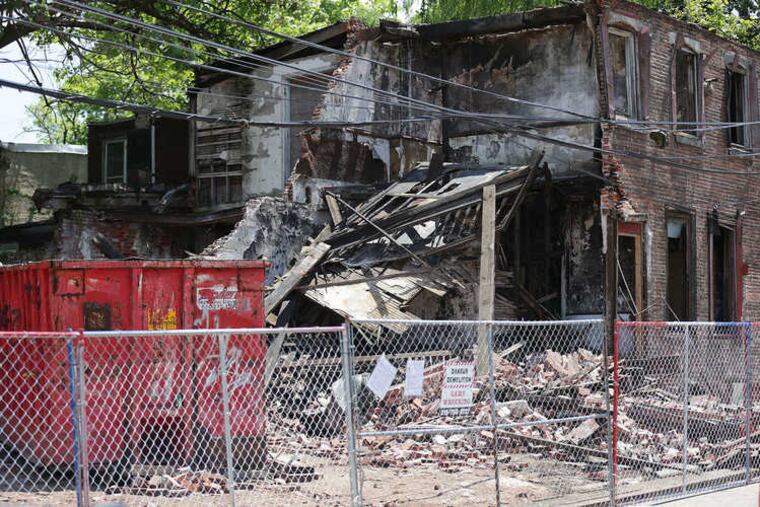Philly contractor faces $45,000 in OSHA fines for Brewerytown building collapse that killed one in June
Contractor Harvey Figgs was killed when the property he was demolishing by hand collapsed, dumping bricks and rubble on top of him. OSHA determined that his employer, Gama Wrecking Inc., had not properly braced walls and floors, or set up a "personal fall arrest system."

One mild Sunday evening last year, Harvey Figgs walked into Morton’s the Steakhouse at the King of Prussia Mall craving the ribeye, his favorite steak.
He was turning 59, children and grandchildren by his side. The group — more than a half-dozen — came to celebrate the man they said was “a stand-up guy” who had “a wonderful work ethic,” and finished the night with a chocolate sundae with a flickering candle on top.
The next morning, after a weekend of heavy rain, Figgs reported to work: a demolition job in fast-changing Brewerytown. The vacant corner property at Jefferson and Bailey Streets had long been a neighborhood nuisance. The property’s new owner, Rollup LLC, registered to Valery Kravets and Alex Yevtushenko, reportedly had plans to build new housing in its place. Figgs, a regular foreman for Gama Wrecking Inc., had been hired to take down the nearly 2,900-square-foot building by hand.
It collapsed on top of him only minutes after he stepped inside, dropping him from the second floor and crushing him with scrap and bricks.
"He hollered, ‘Help me! Help me! Help me!'” Anthony Baker, Figgs’ brother-in-law, told the Inquirer and Daily News in June. “And a bunch of other guys and I tried to dig the rocks off … but it was so many bricks that you just couldn’t get to him.”
By the time investigators arrived, Figgs had died. A man working with him was able to escape uninjured. Figgs, a contractor with more than 20 years of experience, is one of at least two dozen workers who have been killed on a Philadelphia construction site in the last three years.
Investigators still do not know for certain what caused the building, at 2621 W. Jefferson St., to fall. The Department of Licenses and Inspections determined that a previous fire had damaged the building’s joists. Additionally, L&I said, the joists were not cut at an angle that would have prevented the building’s masonry wall from falling even if the floor collapsed.
Yet “the department has never attributed the collapse to the fire,” said Karen Guss, a spokesperson for L&I.
An investigation by the federal Occupational Safety and Health Administration did conclude that more could have been done to protect the workers' safety. In a 10-page report issued last month, OSHA cited Gama Wrecking for three violations, amounting to a penalty fine of $45,656.
Two violations were designated as “serious,” meaning the hazard was so severe that it “would most likely result in death or serious physical harm.” The third was classified as “willful,” meaning an “employer either knowingly failed to comply with a legal requirement ... or acted with plain indifference to employee safety.”
According to the report, Gama failed to shore up or brace walls or floors — a requirement of working within a damaged structure that is being demolished. By failing to put a system such as beams on the walls or scaffolding, Gama was issued a “willful” and a “serious” violation.
Additionally, OSHA issued a “serious” citation for Gama’s failure to use a guardrail, safety net, or personal fall-arrest system, such as a body harness, at a construction site where the vertical drop was greater than six feet.
Gama did not respond to requests for comment. Kravets and Yevtushenko of Rollup also did not return calls.
Brock Atkins, an attorney with the Tucker Law Group who is representing Figgs' family, said family members are still trying to figure out who is responsible for the accident.
“We are glad that OSHA has discovered some of the wrongdoing that happens when contractors cut corners,” Atkins said, adding that it has been a “tough year” for the family. No litigation has been filed, he said.
As Philadelphia has experienced a development boom in the last decade, the construction risks have come into clearer focus. At least 135 people have been killed at construction jobs in Philadelphia since 2008, according to data provided by OSHA. The causes of death range from falls down an elevator shaft to electrocution.
Most building collapses in Philadelphia do not result in fatalities. And many buildings, L&I has said, collapse on their own. Still, with an aging housing stock — portions of which have not been maintained — the city has had numerous buildings collapse during construction in recent years, including, in December, a Francisville property that sent two workers to the hospital.
The worst recent collapse in Philadelphia killed seven people at the Salvation Army building at 22nd and Market Streets in 2013 — an incident that sparked procedural changes when it comes to demolition. According to the L&I spokesperson, Gama had been hired to help clean up rubble from the Salvation Army incident — with Figgs working at the site.
Gama had not experienced a fatality on a job site before Figgs' death in June, OSHA data show. But the company, licensed by Philadelphia, had been cited by the agency multiple times since 2014.
In April, two months before Figgs was killed, OSHA opened an investigation into a property Gama was working on in South Philadelphia.
Eventually, the agency found that Gama had failed to use personal fall-arrest systems — the same thing that OSHA said led to Figgs' death.